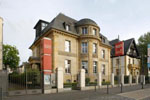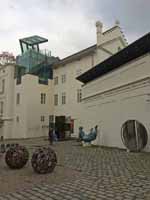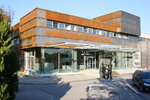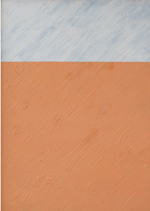
Painter, graphic artist.
Born on 28 July 1932 in Ostrava- Zábřeh, in Moravia, died on 14 July 1988 at Drábsko in then Czechoslovakia.
Until 1956 worked as flight navigator.
In 1958-1964 studied at the Academy of Fine Arts in Bratislava in the studios of P. Matejka and Prof. V. Hložník.
In 1960 founded, together with E. Ovčáček, a Bratislava Confrontations group (exhibitions 1961-1964), introducing non-conventional techniques in structural painting and print into Slovak art.
In addition to prices at home, Urbásek was awarded Folkwang-Presse price in Essen in Germany 1967 and the 1969 prix d' Achat Biennale de Gravure, Ljubljana.
In 1969 received an invitation by the Ford Foundation for a six-months sabbatical in the USA, but was prevented from accepting it by the Czechoslovak authorities.
As one of the first artists in Slovakia, Urbásek focused on geometrical abstraction, the study of which has become a long-term agenda in his work.
He developed an original technique with layered collage and created unique pieces through muchlage.
He later studied and worked with enlarged print serif font and its fragments. An analysis of letter O, reduced to a circle and its parts was completed in monochrome and colour series enabling arbitrary combination of individual pieces into rhythmic dynamic spaces.
Urbásek used the above experience repeatedly to enliven and artistically cultivate architecture.
He experimented with new technologies - print on acryl glass and poured asphalt (1971, Kunsthalle courtyard in Nürnberg in Germany).
Since 1978 Urbásek studied the presence of light in geometrically structured and layered coloured mass in pastels, paintings and drawings.
He participated in a number of action-art performances of his colleagues (with A. Mlynárčik) as well as a younger generation of artists.
Since 1958 lived and worked in Bratislava, specialising in painting, print, drawing, book illustrations and graphic design, as well as monumental works, objects and multiples.
/ biografical data Eva Šefčáková /
museum collections :
Štátna galéria Banská Bystrica
Galéria mesta Bratislavy, Bratislava
Slovenská národná galéria Bratislava
Collection Slovenska sporiteľňa Bratislava
Collection V-INVEST HOLDING, a.s. Bratislava
Collection Gallery Nedbalka Bratislava
Moravská galerie Brno, Oblastní galerie Hodonín Galerie výtvarného umění Karlovy Vary
Galerie Benedikta Rejta Louny
Nitrianska galéria Nitra
Galerie výtvarného umění Ostrava
Národní galerie Praha
České muzeum výtvarných umění Praha
Umělecko-průmyslové muzeum Praha
Dresdner Bank Praha
Galéria M. A. Bazovského Trenčín
Oblastní galerie Zlín
Považská galéria Žilina.
Stedelijk Museum Amsterdam, Netherlands
Akademie voor beeldende Kunsten Arnhem, Netherlands
Graphothek Berlin, BRD
Museum Bochum, BRD
Pinacoteca Nazionale di Bologna, Bologna, Italy
Josef Albers Museum Bottrop, BRD
El Museo de Arte Moderno Jesús Soto Ciudad Bolívar, Venezuela
Kunshalle Bremen, BRD
Oregon State University, Corvallis, U.S.A.
Kupferstich-Kabinett der Staatlichen Kunstsammlungen Dresden, BRD
Leopold-Hoesch-Museum Düren, BRD
Kunstmuseum Düsseldorf, BRD
Museum Folkwang Essen, BRD
Muzeum Okregowę Chełm, Poland
Museum für Konkrete Kunst Ingolstadt, BRD
Muzeum umění V. M. Vasněcova Kirov, Russia
Mittelrhein Museum Koblenz, BRD
Artothek Köln, BRD
Muzeum Koszalińske Koszalin, Poland
Overbeck-Gesellschaft Lübeck, BRD
Moderna Galerija Ljubljana, Slovenia
Städtische Kunstsammlungen Nürnberg, BRD
Horst-Janssen-Museum Oldenburg, BRD
Janus Panonius Múzeum Pécz, Hungary
Mazovian Centre of Contemporary Art "Elektrownia", Radom, Poland
Kunstforum Ostdeutsche Galerie Regensburg, BRD
Städtliche Galerie Haus Seel Siegen, BRD
National Museum Skopje, Republic of Macedonia
Bibliotheca Vaticano, Vatican, VA
Library of congres Washington, U.S.A.
Von der Heydt-Museum Wuppertal, BRD
Albertina Wien, Austria
His works are represented in a number of public as well as private collections, mainly in Slovakia, Czech Republic, Germany, Switzerland, France, Netherlands, Italy, Portugal, Poland, Hungary, Canada and U.S.A.
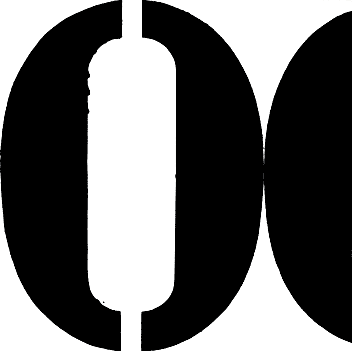
Jiří Valoch /
The Work of Miloš Urbásek
I am convinced that the work of Miloš Urbásek - alas brought to an untimely end - is among the most distinctive, but above all the finest, to be created in post-war Slovak and Czechoslovak art. Urbásek was a highly focused artist and one who reacted with sensitivity and unbridled authenticity to the concerns of the day. Both of these aspects are important. Urbásek’s work - particularly in the first decade of his solo endeavour - addressed the issue of the day; but instead of merely assuming what was already known, he took part in shaping the issue with his own responses, and these were in the main very far-reaching and fundamental. He was of a generation of artists who, if they were to see their work as authentic and meaningful, had a dual task in the particular political situation in Czechoslovakia: to renew the severed ties with the legacy of the founding generations and to find an agenda of their own. This would have to transcend premises which had by then become history and be at least roughly comparable with what their coevals and elders had attempted in countries where the vital continuity of modern art had not been suspended, or the suspension had been relatively brief - namely during the Second World War. The ideological vision of Socialist Realism that was promoted in the 1950s had to be rejected not only in principle, but above all in practice. In the specific Czechoslovak context this meant retracing the way back to the legacy of those who laid the foundations of modern art in the Czech Republic, to the generation of Czech Expressionism and Cubism - and this at a time when their oeuvre was still absolutely inaccessible officially, having vanished from galleries. The artists - both young and older - who sought to renew this bond through their creative work were seconded by scholars who wanted to rehabilitate at least the ‘classic modernism’ through exhibitions and publications - the first exhibition taking place at Brno’s House of Art in 1957 (!). For Urbásek, as for some of his fellow artists and friends, this meant above all looking to the example of Bohumil Kubišta, whose course from Expressionism to Cubism confirmed that Cubist syntax could rest on an attempt at a maximal autonomy of image composition understood as a pure series, something which he had proved with his analyses of the composition of major paintings - analyses which almost forty years later the young were studying and applying to their own essays.
Urbásek was born in Ostrava, in northern Moravia, and embarked on his studies only after a period spent as an air force pilot, when he was already beginning to make his explorations within a small collective of three Ostrava devotees of the modern art cause, his companions being Eduard Ovčáček and Rudolf Valenta. In 1958 he began studying at the Academy of Fine Arts in Bratislava, a city to which he remained true for the rest of his life. It was while still a student that the first period of his authentic work began to develop. He was among those who, after assessing the lesson of Cubism, pledged themselves to a programme of purely non-objective, non-representational art, though such art was at that time totally unacceptable to the state institutions. When an essentially illegal studio showing took place in Prague in 1960 of young artists attempting a specifically Prague modification of art informel in the form of an updating of material abstraction, Urbásek joined Ovčáček in initiating a similar unofficial presentation of young artists in Bratislava. Given the differences between Prague and Bratislava, however, this showing - entitled Konfrontácia (Comparison) - actually embraced all types of outlawed abstraction, from the structural to the geometric. By this time Urbásek was already clear-sighted in his attempt at a distinct form of structural abstraction (his first known abstract picture is from 1959). This was defined not by any endeavour to foreground individual or social woe, existential plights or personal mini-dramas, as was the case with the Prague artists; rather, he was interested from the outset by material structure as a new avenue for the work of art’s articulation, with the emphasis on its compositional anatomy, and as a path to the objectivisation of the creative process. For this reason, of all the Prague artists he had most affinity with one of the pioneers, and the inventor, of structural printmaking, Vladimír Boudník. Structural printmaking, often in the form of a monotype series, acquired in Urbásek’s work an almost monochrome character, the pictures from the years 1963-1964 resulting in the most radical approach, which was a vertical composition created with two fields distinguished by the quality of the material structure. The extensive thematisation of verticality accented the image as an autonomous reality. A counterpart in printmaking came in a 1964 set of etchings pre-conceptually thematising the symbiosis of a fortuitously arising, quasi-‘informal’ structure with a minimalistic linear definition. In this way Miloš Urbásek re-evaluated for himself the possibilities of informel, a phenomenon much in evidence in the Czech and Slovak environment of the time; but he simultaneously marked out his movement towards a fresh conception of the work of art bound with the ‘new sensibility’ which was then prominent throughout Europe.
Urbásek’s affinity with the urban environment, with the nature of urban communication, was revised first in the collages made from fragments of found posters (from 1963), which comprise one form of his hallmark structures. Over time his theme became the letter: isolated graphemes reflecting the world of urban communication, but taken more and more out of their context and presented as an individual theme of the painting, drawing or print. ‘Liberated letters’ presented as an autonomous communicative quality either in the form of asemantic jumble (for example, in the stamp drawings), or enlarged, monumental, isolated, and discovered as a new aesthetic message reflecting the world of linguistic communication - a world which, however, it irrevocably transcends. The cycles Ciphers and Cipher Machines (both from 1965) saw the definitive application of the principle of serial composition, to be developed the following year in etchings and paintings. Here Urbásek joins an essentially (Neo-)Constructivist syntax with elements of written character. The various ways in which he manipulates with these (for example, phasing, ordering of fragments, gradual increase and disappearance), prove themselves aesthetically very effective and are surely one of the crowning achievements of Czechoslovak art of their time. As soon as the solitary, isolated grapheme - perhaps subjected to a certain visual operation - became the theme in the paintings, it could be placed into larger syntactical structures: into a metatext, as it were, if we take that isolated and variously modified grapheme as a sui generis text. Urbásek employed his own stencils in his work, and this enabled him to use the traces of paint which occurred as a chance by-product of his manipulation with the stencil as an aesthetic enhancement of the extra-aesthetic aspect. After investigation of what the letter - above all the grapheme ‘O’ (though actually we do not know if it is ‘O’ or nought) - had to offer, it was a logical step to a yet simpler, absolute formation: the black circle. By dividing this along the axis he acquired elements which could be combined using various systems (1968) - Miloš Urbásek thus absolutised as an aesthetic message the exact rules of composition and the possibilities of combinative links between the elements .
In the 1960s the artist’s path was rapid indeed: he was captivated by the discovery of new possibilities and sought as quickly as possible to exhaust their various aspects. Correspondence, exhibitions, the interest of others in his work: all inspired him to new discoveries. In 1968 he first used colour as an object of serial composition: the minimalist formation - most frequently a quarter-circle or a circle with a core - remained morphologically unchanged, and the aesthetic message was multiplied by finding colour variants whose configuration could be modified in different ways. He remained true to Neo-Constructivist practice to the end of the 1970s. It was a time in which he was reduced to isolation in the studio, occasional contacts with other countries and intimate exhibitions in semi-legal or illegal venues; the tempo of his work in these circumstances slackened, but he continued to advance his case. He created charts using silk-screen printing (of which he was a pioneer in Czechoslovakia), variously modifying and developing his basic theme of the circle or its segment. A special place falls to his ‘homages’: Homage to Albers is in fact a transcription of pieces from that artist’s Homage to the Square series into the Urbásek circle; Homage to El Lissitzky is, on the contrary, a synthetically very rich avowal stating his conviction of the legitimacy of Constructivist art in the environment in which he lived. (Let us not forget that at the time knowledge of the Russian revolutionary avantgardes was only in its infancy.) Both homages were, in fact, an expression of an awareness of the context to which his work belonged. Up to the end of the 1960s Urbásek delved in his pictures into the aesthetic and communicational qualities of two-work or four-work sets which were a challenge to the viewer to discover new aspects of the ‘open work’. Various combinatory possibilities, restricted by the artist’s ‘rules of the game’, were coupled with Constructivist organisation, but also with subtle tonality. The path led from developing the combinatory potential of circle fragments through a more involved compositional approach, to a linear simplicity.
The last decade of the artist’s life and work, ended by his premature death (doubtless brought on by the involuntary isolation in which he found himself because of his work), is equally as important as what had gone before. Despite unpropitious external circumstances, it was a period which saw a progressive modification in the way he used the language of geometry: more than a symbiosis with the issue of the moment, as in the first decade of his work, what was important now was the uniqueness and irreplacability of his own summing-up of experiences from previous periods and their new application. He remained true to the language of geometry, but this was now part of a more complex, differentiated message. The resistance to a more verbalisable content remained, however, and again everything is played out within the pure immanence of the visual-art work and its means of articulation. The autonomy of image composition is formed with a very simple scriptural recording, which we can rightly regard as a renewal of Urbasek’s interest in the letter. But he was no longer interested, as he had been in the 1960s, by the codified form of the grapheme and its aesthetic evaluation. He was interested in an original scriptural recording, the actual motricity of the human hand, the minimal writing gesture, the individual unique visual expression. This then became part of a higher syntactic whole. For a long time Urbásek used as the organising series the linear structure present in the Ingres papers. The ‘formula in the background’ is again a geometrical, essentially minimalistic, disposal of the surface, but these surfaces are each further articulated by numerous serried scriptural marks in oil or pastel. Perhaps we could most generally characterise the themes of these pieces as an interworking between the impersonal series and its particular content, between the generality of the rule and the originality of the materialisation. However, a greater importance now accrues to the values of the colours, the working of light and its involvement in the presentation of colour - all in harmony with the serial principle, which again in a modified form becomes the determinant element of the work. This is reflected not only in the nature of writing, in the repetitive scriptural act, but also in a further level (one superior to this writing): in the sequence of ‘lines’. The individual bands of writing follow one below the other, and we can take this as a reference to the codified system of writing and reading in our cultural setting; but we can also see in it the reflection of the artist’s simple divisions familiar to us from his etchings of the 1960s. For a long time Urbásek emphasised the immanent capacity of his chosen system to generate aesthetically relevant structures, the role of the artist being to define the rules of the game and to do this through the choice of the repertoire of elements and the choice of system on the basis of which the individual visual operations are performed. Also now ‘coming into play’ is the artist himself with his particular preferences and with the attributes of his own motor function.
One abiding challenge for Miloš Urbásek was monochrome, even if he never made of it his creed, which would have countered the nature of his questing and, earlier, synthesising type of talent. But he was the only artist in Czechoslovakia to keep returning to monochrome and to have things to say in his works that were truly vital to it. Indications of this came as early as the structures from 1962 to 1964 and some stamp drawings from 1965. In the final period of his work we find numerous paintings thematising a white monochrome treatment of the scriptural act, but also the practical investigation of the aesthetic and semantic difference made by different monochromes of identical red - for once almost smoothly applied - in terms of changing the format of the picture. A key theme of the painting and pastels was the linking of two layers of colour, where the surface white or violet is modified, for example, by a black ground. The subtlety of differentiations at each place which is intrinsic to the drawing or painting process can also be felt - depending on the individual disposition and orientation of the percipient - as a transcendental quality, which in fact applies also to work with colour as light in more complex work. A further ‘motif within the motif’ is the intermittent highlighting of the unfinished nature of the writing process, the interruption, the inconsummateness of the whole. Both these aspects - the pure monochrome and the thematisation of unfinishedness - make up what are actually the extreme poles of the artist’s aims. Between them we have a large set of works, rather complex in programme terms, wedding the subjective gesture to other forms of organisation - always, however, with a sensibility that is extremely rare in the Czechoslovak context.
In the Slovak and Czech environment, which has customarily preferred the work of visual art to have literary, verbalisable subjects, the oeuvre of Miloš Urbásek has never enjoyed a wholly positive reception. For this it was too closely linked with purely visual-art qualities, it accented too much the autonomy of the composition, it accorded too much recognition to the rationally controllable elements of the work. I think the time has now come for that oeuvre to be accepted in the full measure of its importance.
/ Brno 1989, Bratislava 2000, shorten






